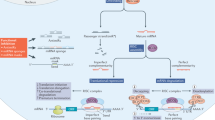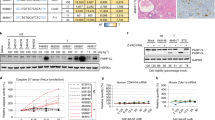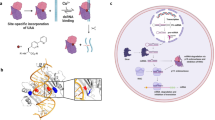Abstract
Nonsense-mediated mRNA decay (NMD) is a cellular quality-control mechanism that is thought to exacerbate the phenotype of certain pathogenic nonsense mutations by preventing the expression of semi-functional proteins. NMD also limits the efficacy of read-through compound (RTC)-based therapies. Here, we report a gene-specific method of NMD inhibition using antisense oligonucleotides (ASOs) and combine this approach with an RTC to effectively restore the expression of full-length protein from a nonsense-mutant allele.
This is a preview of subscription content, access via your institution
Access options
Subscribe to this journal
Receive 12 print issues and online access
$209.00 per year
only $17.42 per issue
Buy this article
- Purchase on Springer Link
- Instant access to full article PDF
Prices may be subject to local taxes which are calculated during checkout


Similar content being viewed by others
References
Goldmann, T. et al. EMBO Mol. Med. 4, 1186–1199 (2012).
Rigo, F., Hua, Y., Krainer, A.R. & Bennett, C.F. J. Cell Biol. 199, 21–25 (2012).
Popp, M.W.-L. & Maquat, L.E. Annu. Rev. Genet. 47, 139–165 (2013).
Keeling, K.M. et al. PLoS One 8, e60478 (2013).
Keeling, K.M. & Bedwell, D.M. Wiley Interdiscip. Rev. RNA 2, 837–852 (2011).
Bhuvanagiri, M. et al. EMBO Mol. Med. 6, 1593–1609 (2014).
Martin, L. et al. Cancer Res. 74, 3104–3113 (2014).
Ni, J.Z. et al. Genes Dev. 21, 708–718 (2007).
Karam, R. & Wilkinson, M. RNA Biol. 9, 22–26 (2012).
Jolly, L.A., Homan, C.C., Jacob, R., Barry, S. & Gecz, J. Hum. Mol. Genet. 22, 4673–4687 (2013).
Shibuya, T., Tange, T.O., Sonenberg, N. & Moore, M.J. Nat. Struct. Mol. Biol. 11, 346–351 (2004).
Kole, R., Krainer, A.R. & Altman, S. Nat. Rev. Drug Discov. 11, 125–140 (2012).
Giorgi, C. & Moore, M.J. Semin. Cell Dev. Biol. 18, 186–193 (2007).
Trecartin, R.F. et al. J. Clin. Invest. 68, 1012–1017 (1981).
Pan, Q. et al. Genes Dev. 20, 153–158 (2006).
Gardner, L.B. Mol. Cancer Res. 8, 295–308 (2010).
Winkler, J., Stessl, M., Amartey, J. & Noe, C.R. ChemMedChem 5, 1344–1352 (2010).
Zhang, Z. & Krainer, A.R. Proc. Natl. Acad. Sci. USA 104, 11574–11579 (2007).
Trcek, T., Sato, H., Singer, R.H. & Maquat, L.E. Genes Dev. 27, 541–551 (2013).
Keeling, K.M., Xue, X., Gunn, G. & Bedwell, D.M. Annu. Rev. Genomics Hum. Genet. 15, 371–394 (2014).
Loughran, G. et al. Nucleic Acids Res. 42, 8928–8938 (2014).
Baker, B.F. et al. J. Biol. Chem. 272, 11994–12000 (1997).
Jeong, J.-Y. et al. Appl. Environ. Microbiol. 78, 5440–5443 (2012).
Hossain, M. & Stillman, B. Genes Dev. 26, 1797–1810 (2012).
Mayeda, A. & Krainer, A.R. Methods Mol. Biol. 118, 315–321 (1999).
Mayeda, A. & Krainer, A.R. Methods Mol. Biol. 118, 309–314 (1999).
Zheng, W., Finkel, J.S., Landers, S.M., Long, R.M. & Culbertson, M.R. Genetics 180, 1391–1405 (2008).
Acknowledgements
We thank F. Bennett for helpful discussions. This work was supported by US National Institutes of Health (NIH) grants R21-NS081448 and R37-GM042699 and by a research grant from the University of Pennsylvania's Center for Orphan Disease Research and Therapy to A.R.K. T.T.N. was supported by NIH grants T32GM008444 and F31NS087747. We acknowledge assistance from Cold Spring Harbor Laboratory Shared Resources, funded in part by Cancer Center Support Grant 5P30CA045508.
Author information
Authors and Affiliations
Contributions
T.T.N., I.A. and A.R.K. designed the experiments. I.A. and F.R. provided critical reagents. T.T.N. performed the research. T.T.N. and A.R.K. wrote the manuscript. All authors approved the manuscript.
Corresponding authors
Ethics declarations
Competing interests
T.T.N., I.A. and A.R.K. have filed a patent application (PCT/US2014/054151) on this technology; F.R. is an employee of and A.R.K. is a consultant and collaborator for Isis Pharmaceuticals.
Integrated supplementary information
Supplementary Figure 1 Baseline expression levels comparing wild-type (WT) and three variants of the T39-PTC HBB constructs.
T39 and T39+24 mRNAs were reduced by approximately 95%, and T39(UGAC) was reduced by approximately 85%. n = 3 independent transfections, error bars represent s.d.
Supplementary Figure 4 Baseline expression levels of MECP2 wild type (WT) and S65X mRNA.
MECP2 (S65X) undergoes efficient NMD, resulting in a 95% reduction in mRNA level, compared to the wild-type mRNA (n = 3 independent samples).
Supplementary Figure 5 Screen of 19 ASOs targeting the last EJC of MECP2.
100 nM of each ASO was transfected, expression of the stably integrated minigene was induced with 1 µg/ml tetracycline at 6 hr post-transfection, and RNA was isolated at 48 hr post-transfection. mRNA was measured by radioactive RT-PCR and quantitated on a phosphorimager. The fold change relative to no-ASO transfection is indicated below each lane.
Supplementary Figure 6 NMD inhibition by ASOs is specific to the targeted transcript.
Four known endogenous NMD targets15 were tested and remained essentially unchanged upon H-24 ASO treatment of U2OS cells expressing HBB (T39) or M-33 ASO treatment of U2OS cells expressing MECP2 (S65X) cells. The difference in expression levels of the transcripts before and after a 5-hr treatment with the translation inhibitor cycloheximide (CHX; 100 µg/ml) was tested in MECP2 (S65X) expressing cells (top left) to confirm their susceptibility to NMD, which requires translation. n = 3 independent samples, *P < 0.05.
Supplementary Figure 8 Transcript subject to NMD is stabilized by ASO treatment.
HBB-T39 mRNA decay rate after actinomycin D treatment (5 µg/ml) decreased when cells were pretreated with 50 nM H-24 ASO. *P <0.05; n = 3 independent transfections.
Supplementary Figure 9 EJC-targeting ASOs increase the amount of protein expressed from mRNAs targeted by NMD.
U2OS cells expressing N-terminal GFP-tagged HBB (T39) were transfected with 100 nM H-24 ASO. Western blotting with anti-GFP antibody confirms the increase in truncated protein expression upon NMD inhibition (P < 0.01; n = 3 independent transfections). Numbers below the panel represent the fold changes ± s.d., as calculated by densitometry.
Supplementary Figure 11 Representative western blot corresponding to Figure 2d.
The T39 stop codon (TAG) plus 4 nt downstream were replaced with TGACTAG to promote a low level of spontaneous translational read-through. Anti-GFP antibody detects the truncated GFP-HBB, as well as the full-length read-through product. The cells were transfected with 50 nM of the indicated ASOs, and incubated with or without 1 mg/ml G418.
Supplementary information
Supplementary Text and Figures
Supplementary Figures 1–11, Supplementary Tables 1 and 2 (PDF 1211 kb)
Rights and permissions
About this article
Cite this article
Nomakuchi, T., Rigo, F., Aznarez, I. et al. Antisense oligonucleotide–directed inhibition of nonsense-mediated mRNA decay. Nat Biotechnol 34, 164–166 (2016). https://doi.org/10.1038/nbt.3427
Received:
Accepted:
Published:
Issue Date:
DOI: https://doi.org/10.1038/nbt.3427
This article is cited by
-
Effects of combinations of gapmer antisense oligonucleotides on the target reduction
Molecular Biology Reports (2023)
-
Gene-specific nonsense-mediated mRNA decay targeting for cystic fibrosis therapy
Nature Communications (2022)
-
Nonsense-mediated RNA decay and its bipolar function in cancer
Molecular Cancer (2021)
-
Antisense technology: an overview and prospectus
Nature Reviews Drug Discovery (2021)
-
Advances in oligonucleotide drug delivery
Nature Reviews Drug Discovery (2020)



